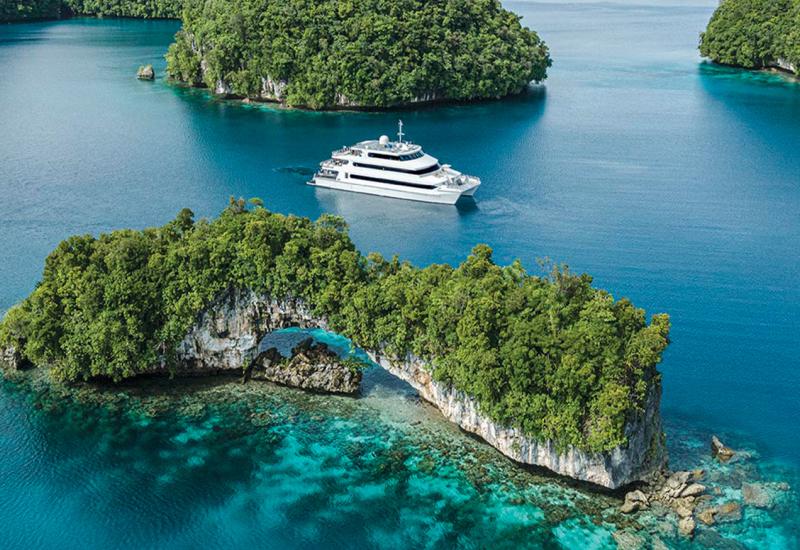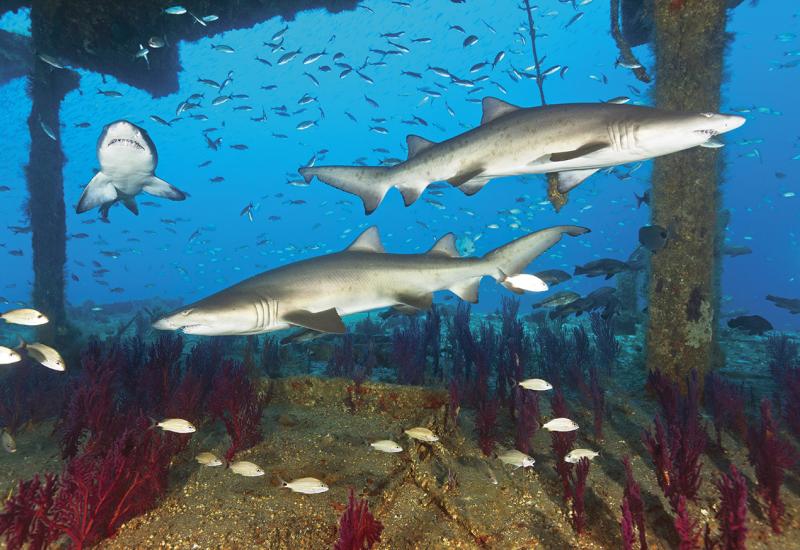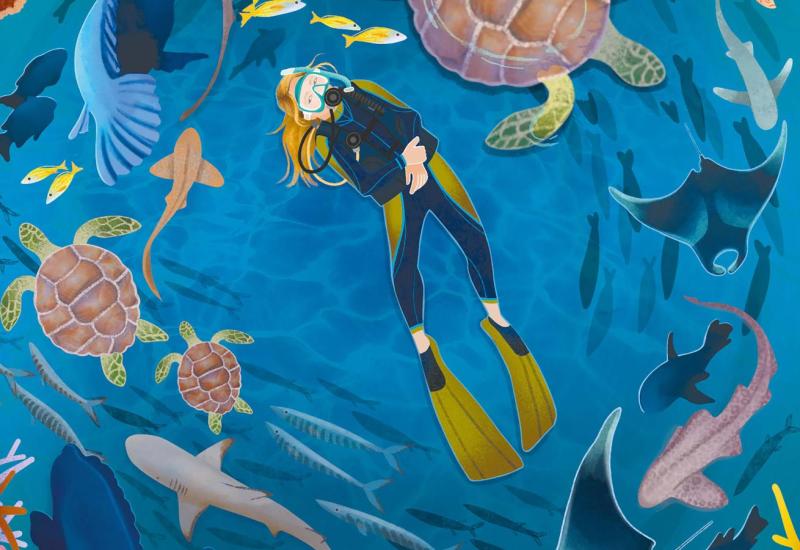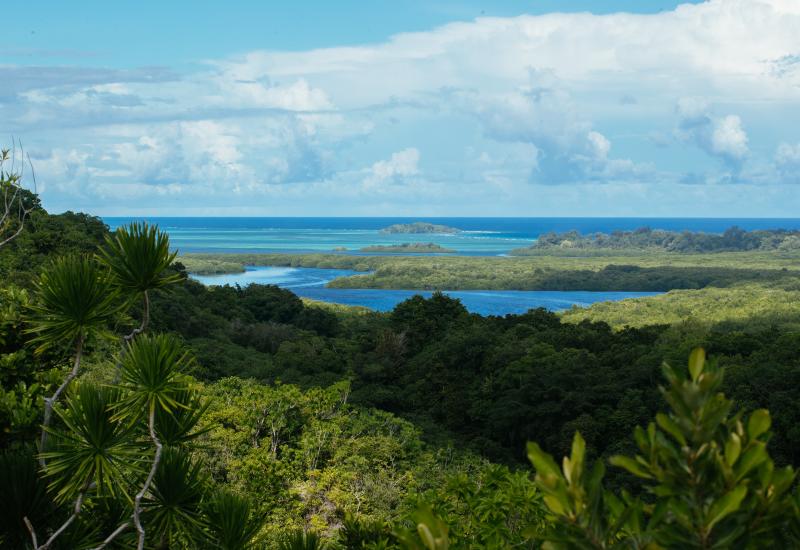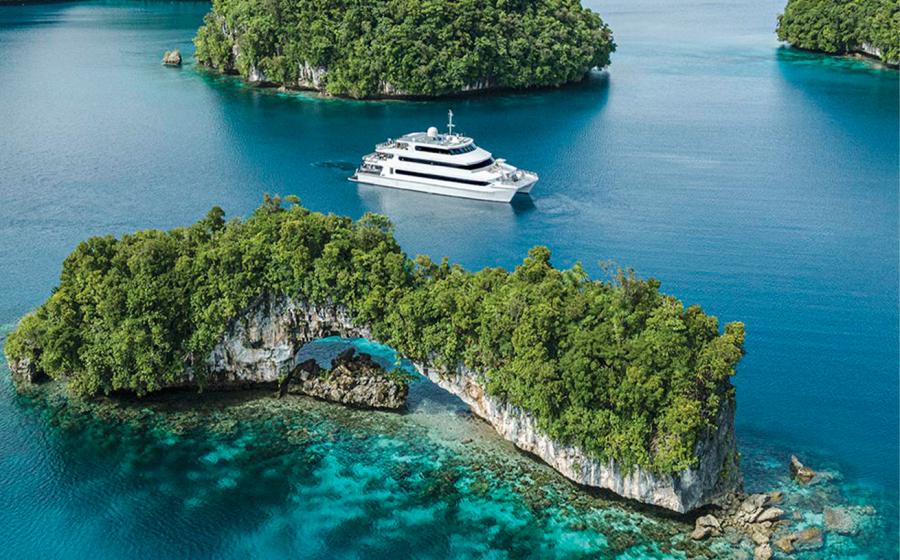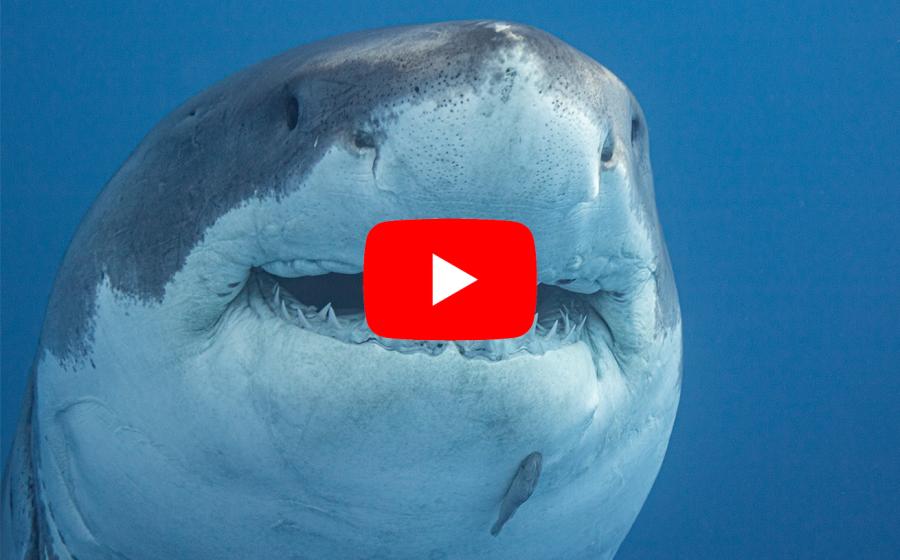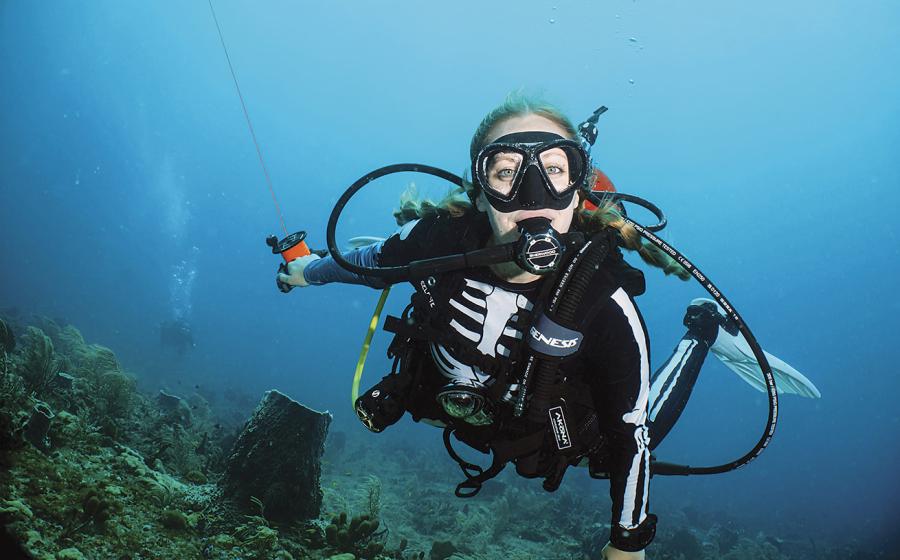Gone with the Wind: Big Current Stories and Strategies for Survival
Chances are that most ocean divers will at some point encounter significant current on a dive. I have a couple of thousand dives under my belt, and have done quite a lot of current dives, but fortunately only a handful of them have been hairy.
Some destinations are known for currents — Cozumel, Galapagos, Discovery Passage in British Columbia, Komodo in Indonesia, Cocos Island in Costa Rica, and Palau in Micronesia are some of the places where I have been diving and have found myself having to manage some significant current.
In locations where the boat is on a fixed mooring, and divers must return to the boat at the end of the dive, it is essential that divers start their dive into the current. This helps to avoid an exhausting swim up-wind at the end of a dive, when low air supply and over-exertion can create a stressful, and potentially dangerous, situation.
Streamlining yourself as much as possible by getting horizontal in the water, placing your arms along the sides of your body, holding your camera flush to the back of your thigh, tucking up your dangling gauges and regulators, and staying low near the reef as you swim into current can really help to create less drag, and therefore minimize effort. Stop and rest as needed by holding on to a bare rock — but look carefully first to make sure it is indeed a rock, and not a stonefish, scorpion fish, or other highly venomous, cleverly camouflaged critter!
I have written before about how much I am a fan of the muck stick, and here is another situation where a sturdy metal stick can come in super handy — digging it into a sandy bottom (again, having a good look to make sure you are not harming any critters there), or wedging it into a crack between rocks (also bare of critters) can allow you to pause in current and get your breathing back to normal. Over-breathing your regulator is a very bad feeling — it’s like trying to gulp air through a straw. It is easy to feel panicked when you feel you are not getting enough air, and so it is very important to not over-exert while diving.
It is a good idea to turn the dive when you have used one third of your air, and then enjoy the effortless drift back to the mooring. Spend the rest of your dive under or near the boat looking for cool stuff, which greatly reduces stress because you know exactly where the boat is. In really strong current, it’s a good idea to use the mooring line as a descent and ascent aid, and as a place to hold on during your safety stop. Lots of boats will also run a “granny line” from the top of the mooring line to the ladder, as well as a long surface tag line off the stern of the boat (down current) — which is something you can grab on to and haul yourself back in case you miss the boat on surfacing. All of these can really help minimize the risk of being blown off the boat when trying to descend or re-board, and ending up surfacing far from the boat where it might be difficult to see you. Very often, I’ve found the current is strongest at the surface, especially as it wraps around the hull of the boat, or funnels between the dual hulls of a catamaran.
And one final tip — on dive sites where there are large boulders, a wreck, or other topographical features (canyons, swim-throughs, etc), you can get out of the current by going to the lee (current shadow) of the structure.
In places where live boat diving is the normal practice — that is, where divers drop in, drift with the current, and are picked up by a boat that follows their bubbles, going for a fly in a strong current can be a bit like an amusement ride — unless you are trying to stop to take photos! Often, the group attempts to stay together during a drift dive, and surfaces together, to make it easier for the pickup boat crew to scoop up divers in a clump, and not have to chase all over looking for people. This is the dive practice in Cozumel, where there is almost always a current running south to north — sometimes quite brisk — and staying with the dive guide is essential in Coz as there is a lot of boat traffic, and surfacing without a surface marker buoy (SMB — which is launched from the safety stop), can be downright hazardous to your health.
In places like Galapagos, dive operators tend to request that all divers be on the surface after sixty minutes in the northern, current-swept sites at Wolf and Darwin islands, so that the dinghy drivers can spot and track buddy pairs or small groups that have surfaced together and are drifting. Most safety stops end up in the blue, where there are no visual references (but, if you are lucky, a whale shark or two might do a flyby), and it is easy to drift a significant distance during an ascent and safety stop without realizing it. With the remoteness of places like the Galapagos, Komodo, and Cocos Island, and their typically rough water conditions, it is especially important to carry a stash of safety equipment for making yourself visible on the surface. This should include an SMB and/or a neon dive flag on a collapsible pole that niftily folds up and stows neatly in your BC pocket or on your harness strap (I carry both on every dive, everywhere), a flashlight, a noisemaker - such as a Dive Alert horn and/or whistle, a CD to reflect sun rays, and, ideally, an EPIRB or Nautilus Lifeline, which allow you to send a radio signal to boats in the area. In the case of the Nautilus Lifeline, you can talk to the boat if you are both dialed in on the same channel. This can be very helpful as you can actually describe to the boat where you are. Launching an SMB whenever you leave the reef to start your ascent is an excellent idea, as it gives the crew a chance to track you as you drift and it also alerts other boats in the area that there are divers in the water.
My first ripping current dive was on a dive site in Discovery Passage in British Columbia. This is cold water diving, where divers either wear very thick, layered wetsuits, or bulky drysuits, to provide thermal protection from the chilly water. Almost all diving in this area is timed to tide tables, with the ideal of dropping divers in near the end of a tidal ebb (tide going out) or flood (tide coming in), both of which lead to a period of slack water as the water pauses before it changes direction. The slack in British Columbia current passages can last from twenty minutes or more in a small tidal exchange to as little as a five minute window in a big exchange. Typically, a few minutes into a building current in Discovery Passage, divers will choose to finish their dives and make their way to the surface, as in this particularly tight passage, through which a huge volume of water travels, currents can wind up to ten knots, and more!
On this particular dive, we were delayed waiting for a tardy diver before we could leave from dock, and so were dropped in late, at the end of the slack. We headed down to the reef at about fifty feet, and had just a few minutes of easy diving before the current really started winding itself up. My husband and I became separated as we tried to grapple on to the rocks like big neoprene crabs. He was behind me and was blown off the rocks, which I did not see happen. It was especially stressful in the limited visibility and very strong current to turn around and find myself alone. We did not re-unite until we surfaced (a very long way from where we started) and were each picked up by the boat. It felt like the longest safety stop, ever.
On a wickedly strong current dive in Indonesia a few years ago, our small group found ourselves hiding behind a lone bommie (a large rock covered with corals) on an otherwise pretty flat reef. It was the only place we could find to hide from the very strong flow of water. We collectively agreed to abort the dive and head for the surface, as, with no where else to hide, the current was so strong that we risked traveling a significant distance in the duration of a dive — a risky proposition in such a remote part of the world. As we ascended, we literally flew over a sandy bottom that was pockmarked with Titan Triggerfish nests, and those big, aggressive fish came up in the water column and attacked us incessantly — one actually bit Mr G hard enough, through his wetsuit, that he had painful teeth marks on his leg!
But the biggest doozy dive to date was a recent dive at Blue Corner in Palau. Blue Corner is known for its currents — which bring in large schools of fish, and the sharks that shadow them. On a couple of previous dives on the same trip, we had enjoyed hooking on at the top edge of the wall in strong but manageable current, and watching the action unfurl just in front of us, out in the blue. Huge swarms of jacks, snappers, barracuda, and numerous reef sharks, plus a couple of orbiting, semi-tame, inquisitive Napoleon Wrasse made for hugely entertaining dives. On an afternoon dive at the same site, most of our group had swum down the ledge and were already hooked in at the corner, ready for the show. A few of us stragglers were moseying along in a gentle current, taking pictures of schools of fish, just off the wall, at a depth of fifty feet or so. Without warning, all hell broke loose. What felt like a wall of water came in from the deep, slammed into the vertical wall — picking us up and hurling us across the top of the wall (about thirty feet in depth) — all with unbelievable force. We all barely managed to grab on to the rocks before being blown up into the shallows. So there I was, literally hanging on for dear life with one hand, my body streamed out in the unbelievable current like a flag in a hurricane, my large, bulky camera in the other hand, banging uncontrollably on the rocks behind me, my mask threatening to be dislodged from my face by the sheer force of the current, and my regulator bubbles exploding out in strong, horizontal bursts.
For the first time in my diving life, I really did not know what to do. I feared letting go and being blown in the strong updraft to the surface — there had been no time to dump air from my BC during the rapid ascent, and there were no free hands to deal with it at that point. After numerous days of multiple dives, it was very likely I could get bent on a quick ascent to the surface like that. So there we were, grappled on and pretty much freaked out.
One of the boat’s divemasters crawled his way over to each of us and indicated that we should let go and follow him — it became clear he was very familiar with the terrain, and knew of the one place nearby, away from the edge of the wall, that had a large rock formation behind which we could hide. Using my muck stick, I swam/dragged myself across and up current as I followed him. Totally stressed, breathing hard, we paused behind the rock and all looked at each other with disbelief. After a few more minutes hiding there, literally regrouping, the current subsided a bit, and we were able to lift off, do a controlled ascent and safety stop, and make our way to the surface.
My buddy James Peterson, who was luckily already hooked in at the Corner when the crazy current hit, was able to capture some great footage that illustrates my story with his GoPro on a stick. With his permission, I’ve put together a short video about this memorable, and scary, “Dive From Hell.”
Judy G is a traveling underwater photographer. Check out her blog HERE and follow her on Facebook: Judy G Diver
More from Judy G
Don't Be This Diver — What Not To Do Underwater
Chances are that most ocean divers will at some point encounter significant current on a dive. I have a couple of thousand dives under my belt, and have done quite a lot of current dives, but fortunately only a handful of them have been hairy.
Some destinations are known for currents — Cozumel, Galapagos, Discovery Passage in British Columbia, Komodo in Indonesia, Cocos Island in Costa Rica, and Palau in Micronesia are some of the places where I have been diving and have found myself having to manage some significant current.
In locations where the boat is on a fixed mooring, and divers must return to the boat at the end of the dive, it is essential that divers start their dive into the current. This helps to avoid an exhausting swim up-wind at the end of a dive, when low air supply and over-exertion can create a stressful, and potentially dangerous, situation.
Streamline
Streamlining yourself as much as possible by getting horizontal in the water, placing your arms along the sides of your body, holding your camera flush to the back of your thigh, tucking up your dangling gauges and regulators, and staying low near the reef as you swim into current can really help to create less drag, and therefore minimize effort. Stop and rest as needed by holding on to a bare rock — but look carefully first to make sure it is indeed a rock, and not a stonefish, scorpion fish, or other highly venomous, cleverly camouflaged critter!
Stick With It
I have written before about how much I am a fan of the muck stick, and here is another situation where a sturdy metal stick can come in super handy — digging it into a sandy bottom (again, having a good look to make sure you are not harming any critters there), or wedging it into a crack between rocks (also bare of critters) can allow you to pause in current and get your breathing back to normal. Over-breathing your regulator is a very bad feeling — it’s like trying to gulp air through a straw. It is easy to feel panicked when you feel you are not getting enough air, and so it is very important to not over-exert while diving.
Point of Reference
It is a good idea to turn the dive when you have used one third of your air, and then enjoy the effortless drift back to the mooring. Spend the rest of your dive under or near the boat looking for cool stuff, which greatly reduces stress because you know exactly where the boat is. In really strong current, it’s a good idea to use the mooring line as a descent and ascent aid, and as a place to hold on during your safety stop. Lots of boats will also run a “granny line” from the top of the mooring line to the ladder, as well as a long surface tag line off the stern of the boat (down current) — which is something you can grab on to and haul yourself back in case you miss the boat on surfacing. All of these can really help minimize the risk of being blown off the boat when trying to descend or re-board, and ending up surfacing far from the boat where it might be difficult to see you. Very often, I’ve found the current is strongest at the surface, especially as it wraps around the hull of the boat, or funnels between the dual hulls of a catamaran.
And one final tip — on dive sites where there are large boulders, a wreck, or other topographical features (canyons, swim-throughs, etc), you can get out of the current by going to the lee (current shadow) of the structure.
Go With the Flow
In places where live boat diving is the normal practice — that is, where divers drop in, drift with the current, and are picked up by a boat that follows their bubbles, going for a fly in a strong current can be a bit like an amusement ride — unless you are trying to stop to take photos! Often, the group attempts to stay together during a drift dive, and surfaces together, to make it easier for the pickup boat crew to scoop up divers in a clump, and not have to chase all over looking for people. This is the dive practice in Cozumel, where there is almost always a current running south to north — sometimes quite brisk — and staying with the dive guide is essential in Coz as there is a lot of boat traffic, and surfacing without a surface marker buoy (SMB — which is launched from the safety stop), can be downright hazardous to your health.
Come Prepared
In places like Galapagos, dive operators tend to request that all divers be on the surface after sixty minutes in the northern, current-swept sites at Wolf and Darwin islands, so that the dinghy drivers can spot and track buddy pairs or small groups that have surfaced together and are drifting. Most safety stops end up in the blue, where there are no visual references (but, if you are lucky, a whale shark or two might do a flyby), and it is easy to drift a significant distance during an ascent and safety stop without realizing it. With the remoteness of places like the Galapagos, Komodo, and Cocos Island, and their typically rough water conditions, it is especially important to carry a stash of safety equipment for making yourself visible on the surface. This should include an SMB and/or a neon dive flag on a collapsible pole that niftily folds up and stows neatly in your BC pocket or on your harness strap (I carry both on every dive, everywhere), a flashlight, a noisemaker - such as a Dive Alert horn and/or whistle, a CD to reflect sun rays, and, ideally, an EPIRB or Nautilus Lifeline, which allow you to send a radio signal to boats in the area. In the case of the Nautilus Lifeline, you can talk to the boat if you are both dialed in on the same channel. This can be very helpful as you can actually describe to the boat where you are. Launching an SMB whenever you leave the reef to start your ascent is an excellent idea, as it gives the crew a chance to track you as you drift and it also alerts other boats in the area that there are divers in the water.
Big Current in B.C.
My first ripping current dive was on a dive site in Discovery Passage in British Columbia. This is cold water diving, where divers either wear very thick, layered wetsuits, or bulky drysuits, to provide thermal protection from the chilly water. Almost all diving in this area is timed to tide tables, with the ideal of dropping divers in near the end of a tidal ebb (tide going out) or flood (tide coming in), both of which lead to a period of slack water as the water pauses before it changes direction. The slack in British Columbia current passages can last from twenty minutes or more in a small tidal exchange to as little as a five minute window in a big exchange. Typically, a few minutes into a building current in Discovery Passage, divers will choose to finish their dives and make their way to the surface, as in this particularly tight passage, through which a huge volume of water travels, currents can wind up to ten knots, and more!
On this particular dive, we were delayed waiting for a tardy diver before we could leave from dock, and so were dropped in late, at the end of the slack. We headed down to the reef at about fifty feet, and had just a few minutes of easy diving before the current really started winding itself up. My husband and I became separated as we tried to grapple on to the rocks like big neoprene crabs. He was behind me and was blown off the rocks, which I did not see happen. It was especially stressful in the limited visibility and very strong current to turn around and find myself alone. We did not re-unite until we surfaced (a very long way from where we started) and were each picked up by the boat. It felt like the longest safety stop, ever.
Take Cover
On a wickedly strong current dive in Indonesia a few years ago, our small group found ourselves hiding behind a lone bommie (a large rock covered with corals) on an otherwise pretty flat reef. It was the only place we could find to hide from the very strong flow of water. We collectively agreed to abort the dive and head for the surface, as, with no where else to hide, the current was so strong that we risked traveling a significant distance in the duration of a dive — a risky proposition in such a remote part of the world. As we ascended, we literally flew over a sandy bottom that was pockmarked with Titan Triggerfish nests, and those big, aggressive fish came up in the water column and attacked us incessantly — one actually bit Mr G hard enough, through his wetsuit, that he had painful teeth marks on his leg!
The Grandaddy of Them All
But the biggest doozy dive to date was a recent dive at Blue Corner in Palau. Blue Corner is known for its currents — which bring in large schools of fish, and the sharks that shadow them. On a couple of previous dives on the same trip, we had enjoyed hooking on at the top edge of the wall in strong but manageable current, and watching the action unfurl just in front of us, out in the blue. Huge swarms of jacks, snappers, barracuda, and numerous reef sharks, plus a couple of orbiting, semi-tame, inquisitive Napoleon Wrasse made for hugely entertaining dives. On an afternoon dive at the same site, most of our group had swum down the ledge and were already hooked in at the corner, ready for the show. A few of us stragglers were moseying along in a gentle current, taking pictures of schools of fish, just off the wall, at a depth of fifty feet or so. Without warning, all hell broke loose. What felt like a wall of water came in from the deep, slammed into the vertical wall — picking us up and hurling us across the top of the wall (about thirty feet in depth) — all with unbelievable force. We all barely managed to grab on to the rocks before being blown up into the shallows. So there I was, literally hanging on for dear life with one hand, my body streamed out in the unbelievable current like a flag in a hurricane, my large, bulky camera in the other hand, banging uncontrollably on the rocks behind me, my mask threatening to be dislodged from my face by the sheer force of the current, and my regulator bubbles exploding out in strong, horizontal bursts.
For the first time in my diving life, I really did not know what to do. I feared letting go and being blown in the strong updraft to the surface — there had been no time to dump air from my BC during the rapid ascent, and there were no free hands to deal with it at that point. After numerous days of multiple dives, it was very likely I could get bent on a quick ascent to the surface like that. So there we were, grappled on and pretty much freaked out.
One of the boat’s divemasters crawled his way over to each of us and indicated that we should let go and follow him — it became clear he was very familiar with the terrain, and knew of the one place nearby, away from the edge of the wall, that had a large rock formation behind which we could hide. Using my muck stick, I swam/dragged myself across and up current as I followed him. Totally stressed, breathing hard, we paused behind the rock and all looked at each other with disbelief. After a few more minutes hiding there, literally regrouping, the current subsided a bit, and we were able to lift off, do a controlled ascent and safety stop, and make our way to the surface.
My buddy James Peterson, who was luckily already hooked in at the Corner when the crazy current hit, was able to capture some great footage that illustrates my story with his GoPro on a stick. With his permission, I’ve put together a short video about this memorable, and scary, “Dive From Hell.”
Judy G is a traveling underwater photographer. Check out her blog HERE and follow her on Facebook: Judy G Diver
More from Judy G
Don't Be This Diver — What Not To Do Underwater

